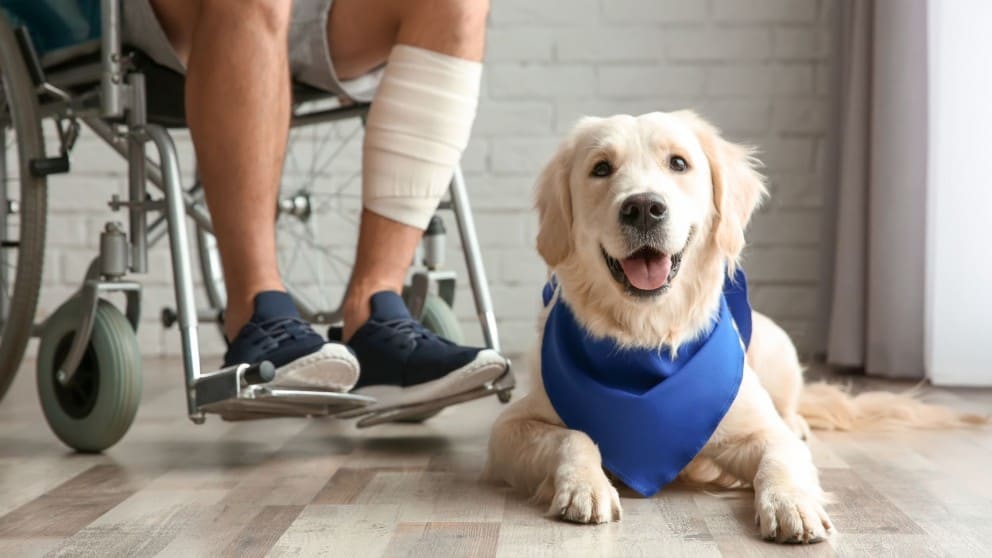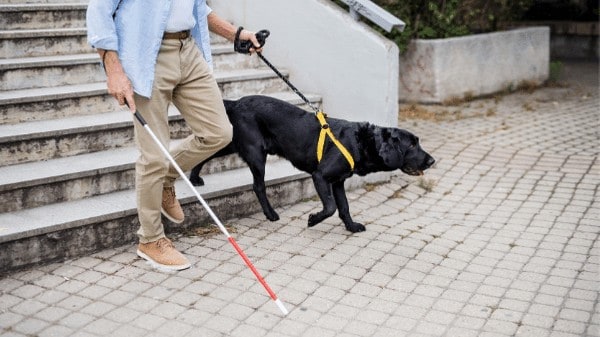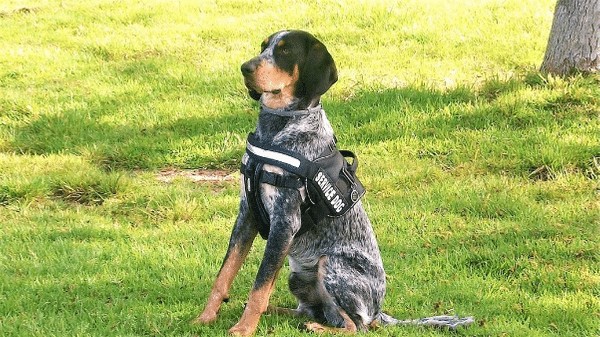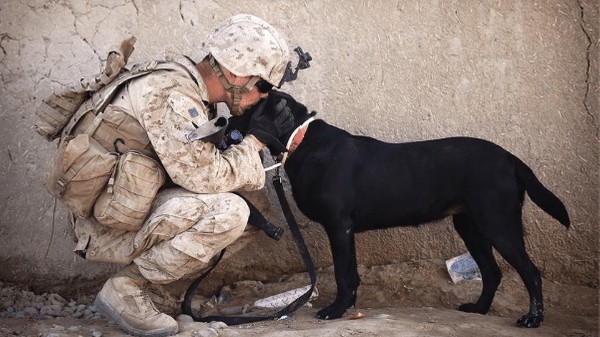Celebrate Working & Service Dogs this Labor Day

On Monday, September 7, 2020, Americans are celebrating the social and economic contributions workers have made to our country’s success with a little something called Labor Day. We want to help celebrate our country’s great achievements by making a huge shout out to all of the working dogs out there. Help us share our appreciation by thanking these 15 types of working dogs who make a real difference.
Guide Dogs
The first category of working dogs can be broken down into several specific roles that these dogs perform. These are the service dogs which have generally been broken down into 10 main categories of services. Guide dogs are probably the most common Service Dog. The job of these dogs is to guide visually impaired and blind people around obstacles in their everyday lives. Both Labradors and Golden Retrievers are the most common breed of guide dogs. While people often expect guide dogs and other assistance dogs to wear vests, the Americans With Disabilities Act does not require a vest, although they’ll often be wearing a special harness with a handle on it.
Hearing Guide Dogs
Next up are hearing dogs. For people with hearing impairments, service dogs assist by alerting their owner to noises such as alarms, doorbells or crying babies. When the dog hears the sound, they’ll touch their human and lead toward the noise. Labradors and Golden Retrievers are breeds that are often chosen as hearing dogs. However, some other breeds including Cocker Spaniels and Miniature Poodles, have been successfully trained to alert as a hearing dog.
Mobility Assistance Dogs
Third, we have the mobility assistance dogs. According to Service Dogs of America, mobility assistance dogs can help bring objects to people, press buttons on automatic doors, serve as a brace for people who are ambulatory or even help pull a wheelchair up a ramp. These dogs help impaired people increase their independence and confidence. People with spinal cord injuries, brain injuries, and even arthritis are among those who can benefit from a mobility assistance dog. Many different breeds can be eligible to become a mobility assistance dog as long as the dog is large enough to support their human partner.

Diabetic Alert Dogs (DAD)
DAD’s or Diabetic Alert Dogs help provide independence and security to their owners by alerting them to chemical changes in blood sugar. These scent changes associated with hyperglycemic or hypoglycemic events in diabetics are imperceptible to humans, but not dogs. These service dogs alert their owner to blood sugar highs and lows before the levels become dangerous. If this occurs, these dogs will alert their owners and they then know to test their blood. Many of these dogs are also trained to alert others in the household or set off a type of alarm system if their owner is in need of help.
Seizure Alert & Response Dogs
Next, there are both Seizure Alert and Seizure Response Dogs. Although they seem very similar, these dogs are trained differently and serve different purposes. First, the alert dogs react with a specific type of behavior right before their human has a seizure. The ability to detect seizures seems to be a natural ability for a small number of dogs, although some neurology experts say there is no reliable evidence to suggest that dogs can reliably predict seizures. On the other hand, many patients, families and trainers insist their dogs do accurately predict and alert to oncoming seizures, and stories about pet dogs who alert without training have received a lot of media attention. Second, the response dogs provide help to a person experiencing an epileptic seizure. These dogs bark for help or to press an alarm system during a person’s seizure. They can also get a person out of an unsafe place. And may bring medicine or a phone to a person who is coming out of a seizure.
Psychiatric Service Dogs
Psychiatric service dogs assist people who are suffering from issues like depression, anxiety and most often post-traumatic stress disorder. The human handlers in this category can feel very concerned about their safety, and these service dogs can make them feel safer by doing things like entering the home before the human, and turning on the lights with a foot pedal. These dogs can also help those suffering from PTSD who feel overwhelmed in public places by creating a physical barrier between the handler and others, giving the handler more personal space. Many PTSD sufferers find that having a service dog to care for allows them to also take care of themselves. Getting out into the world and getting exercise with their dog can help improve the well-being of those suffering from PTSD.

Autism Support Dogs
For children who are autistic, autism support dogs can be vital in providing a sense of predictability as the children navigate social settings. The dogs can be a big help for kids who have trouble connecting with classmates. The canine acts as an icebreaker in social situations. They improve the child’s quality of life by reducing isolation and comforting the child in stressful times. These dogs are also trained to keep children from running away and can track children if they do run off.
Fetal Alcohol Spectrum Disorder Dogs
Another very specific category of service dogs are the FASD Dogs. These dogs support children who were exposed to alcohol prenatally and have been diagnosed with fetal alcohol spectrum disorders or FASDs. These children may have physical or mental difficulties, as well as behavioral problems and learning disabilities. According to 4 Paws for Ability, FASD dogs are trained similarly to autism service dogs. They can also be trained to interrupt repetitive detrimental behavior.
Allergy Detection Dogs
Finally, the last group of service dogs are the allergy detection dogs. Allergy detection dogs are trained to sniff out and alert to the odor of things such as peanuts or gluten. Often partnered with children, allergy detection dogs can be trained to alert to allergy-inducing smells at school. Allergy detection dogs provide kids with a greater sense of independence and giving their parents a greater sense of security.
Therapy Dogs
Therapy dogs provide a slight different service than your typical service dogs. They supply psychological and emotional support to humans. You will typically see them visiting hospitals, schools, and nursing homes making everyone smile. Therapy dogs have a very sweet disposition and enjoy being pet or providing comfort to others. Therapy dogs also receive training and are handled primarily by their owners.

Police Dogs
Police dogs are a very special type of dogs. They are known for their hard working abilities, focus, sense of smell and selflessness. In many situations, police dogs are the first ones to go out in a line of duty and protect their police partners. For this reason, police dog breeds are ones with great strength, agility and intelligence.
The most popular breeds are:
- German Shepherd
- Belgian Malinois
- Labrador Retriever
- Doberman Pinscher
- Boxers
- Beagle
- German Shorthaired Pointer
- Cane Corso
- Bloodhound
Police dogs can be seen accompanying their partners day-to-day, working at airports to detect explosives and drugs, or participating in search and rescue.
Military Working Dogs
Similar to police dogs, military dogs are specially trained for combat, search and rescue, bomb detection and more. They go through vigorous programs in which only about 50% make it through training. What many humans may not know is that military dogs can also suffer the after effects of combat including PTSD and mourning their handlers. We were so happy to hear that many handlers and their families are able to adopt these dogs at the end of service and provide them with happy, loving homes.
Though you may not have a service dog, you’ll want to protect yours like you would a service dog. Get the right coverage for all the medical care they need, even supplemental benefits if that’s what it takes. No matter what, keep your pup healthy and happy.
Planning to get insurance for your fur babies? This article provides a guide to understanding pet insurance.
